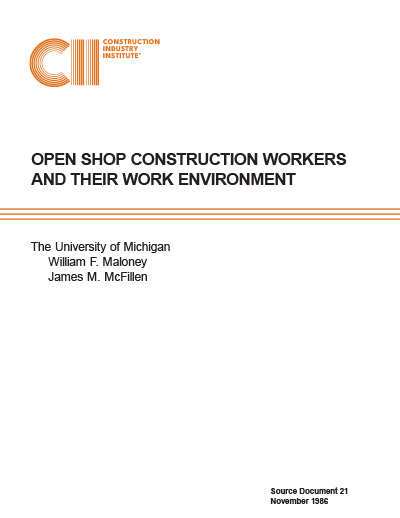
Open Shop Construction Workers and Their Work Environment
Publication No
SD-21
Type
Academic Document
Publication Date
Nov 01, 1986
Pages
140
Research Team
RT-011b
DOCUMENT DETAILS
Abstract
Key Findings
Filters & Tags
Abstract
Key Findings
Motivation is a factor of both expectancy and incentive. Expectancy, or belief that the tasks at hand would be successfully accomplished if one exerted the effort, was high at 77%. Incentive – the expectation to be rewarded for a job well done – scored much lower at 52% and drove an overall low motivation score of 40%. Respondents rated their effort and performance very positively, and their overall job satisfaction as only moderate.
Applying the foregoing, more strongly linking rewards and outcomes most valued by workers to job performance would increase incentive and hence job satisfaction. Extrinsic rewards (pay, benefits, promotions) were most valued by the sample population in this study. (SD-21, p. 103)
Worker motivation is also a function of the work itself. The study identified five basic dimensions of work that influence its intrinsic motivational value: skill variety, task identity, task significance, autonomy, and feedback. The expectation that open-shop construction work would yield a relatively positive motivational environment was NOT realized – workers in this study described their work as fractionalized and “assembly line”, much like a manufacturing industry, with little autonomy or identity. Recreating “pride in craftsmanship” in construction through better task design could substantially contribute to worker motivation, productivity, and satisfaction. (SD-21, p. 58)
Foremen, not surprisingly, are a significant influence on workers. Foremen who support their workers, involve them in decisions, and emphasize performance create a more motivational workplace. Also not surprisingly, bias and punishment negatively impact worker motivation and satisfaction. (SD-21, p. 105)
Contractors motivate workers through the four factors of consideration, reward behavior, work facilitation, and performance orientation. Consideration and work facilitation also improve worker performance, and all four impact worker satisfaction. (SD-21, p. 106)
The more workers participate together as part of a crew, and the more difficult and clear the crew’s goals were, the greater the motivation of each individual worker. Work crew dimensions also influence work quantity, work quality, and general job satisfaction. (SD-21, p. 106)
Workers did not strongly view OSHA safety regulations as being necessary or influential on their productivity. Workers did indicate that their employers emphasized safety and that well-written and consistently enforced safety policies, periodic safety meetings, and managerial emphasis on safety all increased the priority that workers placed on doing their jobs safely. (SD-21, p. 101)
Filters & Tags
Knowledge Area
Project Phase
Project Function
Industry Group
Research Topic
Employee Effectiveness
Keywords
Motivation,
Drugs,
Alcohol,
Performance,
Satisfaction,
Substance Abuse,
Employee Involvement,
rt11



